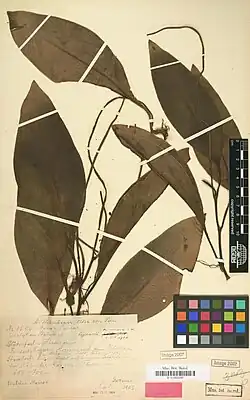Peperomia tenuiramea
| Peperomia tenuiramea | |
|---|---|

| |
| Scientific classification | |
| Kingdom: | Plantae |
| Clade: | Tracheophytes |
| Clade: | Angiosperms |
| Clade: | Magnoliids |
| Order: | Piperales |
| Family: | Piperaceae |
| Genus: | Peperomia |
| Species: | P. tenuiramea
|
| Binomial name | |
| Peperomia tenuiramea | |
Peperomia tenuiramea is a species of epiphyte in the genus Peperomia.[1][2] Its Conservation Status is Not Threatened.[3]
Description
First specimens were collected at Huamalies, at the 600-700 metres elevation.[2]
Its dry stems are about 3 millimetres thick. The leaves alternate. Dry, stiff limbs can measure up to 19 1/2 cm in length and 7 1/2 cm in width. petioles as large as three centimetres.[4]
Glabrous, with long petioled lanceolate leaves, sending 6-7 thin veins on both sides of the central nerve beyond 1/2 its length; branches of spiciferis aphyllis with opposite leaves bearing spikes of 2-3 long lanceolate scales, peduncles much shorter than petioles, spikes slightly exceeding the limbs of densiflora; orbicular plate pedicellate in the centre; anthers elliptic with very short filaments; the ovary emerged above the scutellum, the oblong scutellum pointed at the tip, the stigma inserted below the middle of the scutellum, minute; berry elliptic, strewn with glands at the apex, and sat far down-curved.[4]
Taxonomy and naming
It was described in 1908 by Casimir de Candolle in "Botanische Jahrbücher für Systematik, Pflanzengeschichte und Pflanzengeographie.", from collected specimens by Augusto Weberbauer in 1903.[1][5] It gets its name from Tenui + ramea, which means Thin branches.
Distribution and habitat
It is endemic to Peru.[1][2] It grows on epiphyte environment and is a herb.[4] It grows at 650m ±50m elevation.[2]
References
- ^ a b c "Peperomia tenuiramea C.DC". Plants of the World Online. Royal Botanic Gardens, Kew. Retrieved 3 May 2024.
- ^ a b c d "Peperomia tenuiramea C.DC". Global Biodiversity Information Facility. Retrieved 3 May 2024.
- ^ [1], Angiosperm Extinction Risk Predictions v1
- ^ a b c "Botanische Jahrbücher fur Systematik, Pflanzengeschichte und Pflanzengeographie". Retrieved 3 May 2024.
- ^ "Peperomia tenuiramea C.DC". Tropicos. Retrieved 3 May 2024.